
Professor Cabrera’s Cabinet of Horrors: Secret Chambers and Shocking Artifacts with Controversial Origins
In Ica, Peru, I visited the most mysterious museum on our planet. It is the Museo de Piedras Grabadas de Ica, (Museum of the Engraved Stones of Ica). Professor Javier Cabrera Darquea (1924-2001) created it. The museum offers two archaeological collections—of which one was kept secret for years. Actually, neither of them should exist: they are far too fantastical. But reality is sometimes stranger than even the most impossible fiction.
The Secret Chambers and Shocking Sights
Cornelia Petratu and Bernard Roidinger write in the postscript of their work The Stones of Ica: “Punctual, lively, and full of enthusiasm, Professor Cabrera greeted us in his museum. […] There was nothing in his presentation that could still surprise us. Yet, on the last day, he completed his act. […] And so, Professor Cabrera revealed to us the locked rooms of a house, which he called his ‘secret chambers’. If visiting Cabrera’s private museum had already shocked us, then what we were about to see would exceed all of our imagination. Cabrera’s ‘secret chambers’ contain things that shatter all boundaries of rational logic. Even if we attempted to explain what we saw, we could not. It simply is beyond our grasp.”
What did Cornelia Petratu and Bernard Roidinger see, but were prevented from describing? What images were they not permitted to publish? Or: what did they see and dared not include in their book?
I became aware of the mysterious objects in the private museum of Professor Javier Cabrera Darquea as early as the 1970’s. There was the mention of a public section, as well as a secret part of the mysterious archaeological collection, but concrete information was unavailable. Statements of scientists did not exist. What were Professor Cabrera, and his finds that allegedly ought not exist, all about?
The Secret Collection
I first attempted to view and photograph the mysterious artifact collections of Professor Cabrera in the autumn of 1992. In that year, three friends and I travelled through South America for two months, from Ecuador to Easter Island. When we arrived in Ica and went to Professor Cabrera’s private museum, we were bitterly disappointed. The museum was closed, and there was no one to ask about it. Our ringing of the bell remained unanswered. At last, someone told us: Professor Cabrera was travelling—in Europe. What irony: four Europeans had undertaken the long journey to Ica in Peru, to visit Professor Cabrera, while the scientist was travelling in Europe.
- Eerie Ancient Wax Sculptures for Hexing Enemies, Destroying Demons, and Remembering the Dead
- 11,000 Years Old: New Dating of Shigir Idol reveals it is Oldest Wooden Sculpture in the World
- On the trail of the Father Crespi Collection – Part I
But then, I found the opportunity to speak at length with one of Professor Cabrera’s brothers. He candidly confirmed the existence of a second, secret collection, which he was not permitted to show me without the express approval of his brother. Unfortunately, the latter was out of reach.
Years later it came to pass at last.
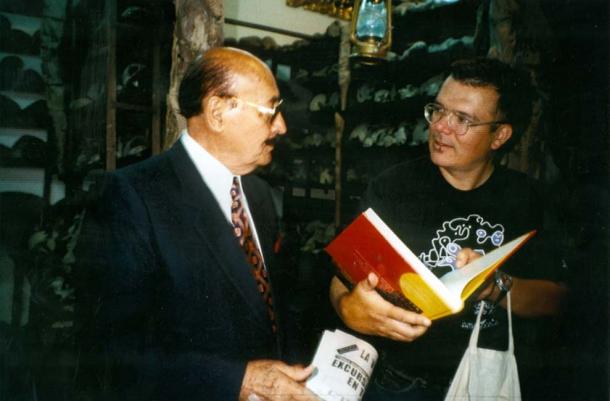
Prof. Cabrera (left) with Walter-Jörg Langbein (Photo by Ingeborg Diekmann)
My eyes slowly became accustomed to the dim light. The air was full of dust. Ahead of me stretched a narrow corridor the other end of which I could only guess. To my right and left stood shelves that reached to the ceiling well above me. Hundreds, no, thousands of clay figurines lay side by side, tightly crowded, several rows deep. It was evident that, over time, new shelves had gradually been added, to create more room for the steadily accumulating mysterious items. The huge collection constantly grew.
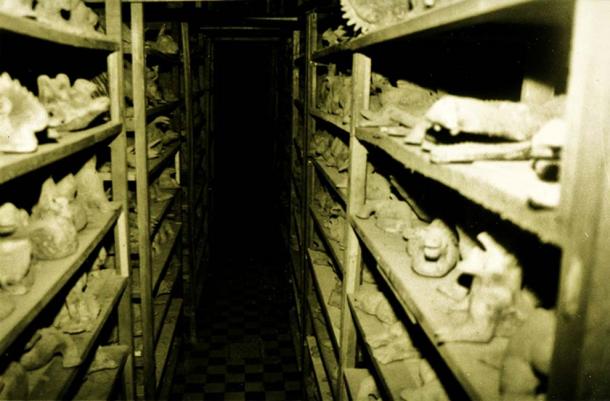
Hundreds of eerie sculptures in the once-secret collection. (© Walter Langbein)
Collection of Horrors
Several naked light bulbs were tied to wires und suspended from the ceiling. Their pale sheen cast an eerie light across the entire scene.
The air was dry and caused me to cough. I slowly walked past the shelves. The cone of light produced by my strong torch glided across the figurines on the shelves. Most consisted of two humanoid figures that presented a grotesque group: one figure lying on a kind of table, and a second one standing beside it, ‘treating’ the one in the prostrate position. The variation of this grouping consisted of the figure standing being in the process of cutting open, or into, the one lying down. In most cases, the ‘surgeon’ had already opened the ‘patient’.
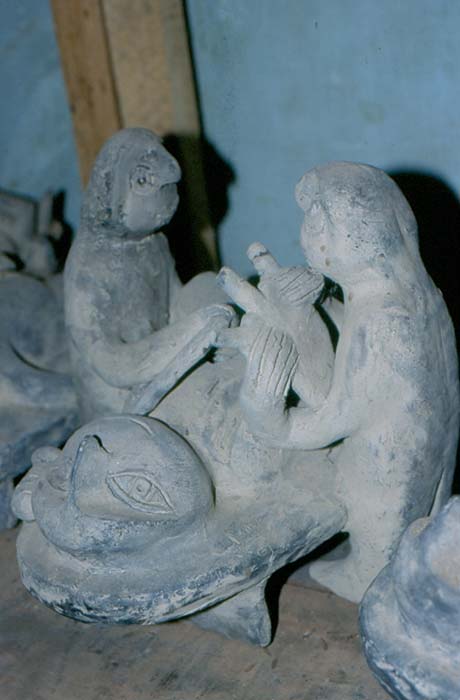
Sculpture depicting heart transplant? (© Walter Langbein)
The many scenes all differed, yet resembled each other very much. I felt as though I had been transported into a stone figure cabinet á la Madame Tussaud—into the horror section. The beings made from grey clay were not life-sized, as in Tussaud’s wax museum, but very much smaller. They stood at the most thirty centimetres (12 inches) tall—I’ve measured them. But unlike at Madame Tussaud’s, where famous individuals have been immortalized, Cabrera’s collection featured mask-like creatures.
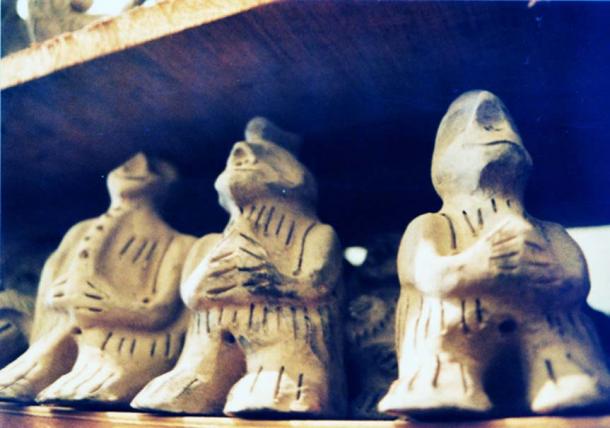
Strange humanoids. (© Walter Langbein)
An entire army of peculiarly identical actors went about their bloody business. A hundred—no, a thousand—operations or autopsies were being carried out. The figures holding the knives did not resemble compassionate physicians trying to help ailing people; no, they gave the impression of being scientists devoid of emotions, abusing human beings as guineapigs, and dissecting them with the curiosity of researchers. Are the ‘surgeons’ human beings at all? Their features seemed rather strange and exotic.
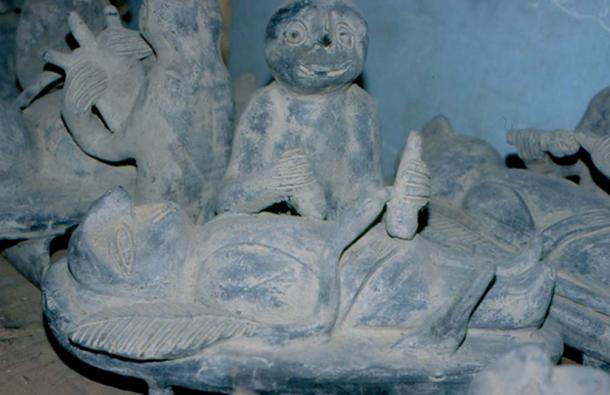
Humanoids experimenting with medical procedures? (© Walter Langbein)

Or performing surgery? (© Walter Langbein)
I saw hundreds, even thousands of such creatures in Professor Cabrera’s secret corridor. They were standing closely packed, side by side. I ought to have had the required weeks at my disposal to photograph each individual piece. Inside dusty cardboard boxes I discovered badly damaged figurines and unidentifiable fragments. Professor Cabrera: “I can exhibit only a small part of the intact figurines in the collection. I lack the necessary time to piece together the broken ones!”
The scientist repeatedly assured me that thousands more such figurines were stored in a cave. The lack of space made it impossible for him to present more than a small fraction of his collection in the secret part of his museum. Professor Cabrera estimated that members of the indigenous population have unearthed approximately fifty thousand archaeological objects. He asserted, again and again, that he had seen about one hundred thousand such mysterious objects in the ‘subterranean tunnel’. “In order to preserve these treasures for posterity, they need to be housed in a large museum. The precious artifacts must be expertly stored, cleaned, catalogued, and exhibited under ideal conditions (temperature, humidity).”
Professor Javier Cabrera Darquea is famous around the world for his unusual archaeological collection. In 1974 Robert Charroux reported in his book L’enigme des Andes about the museum of Professor Cabrera. The English translation was published in 1977, and carried the title The Mysteries of The Andes. There is no mention of the actual sensation—Cabrera’s Cabinet of Horrors. The professor explained: “The time was not yet right!” Will the members of modern science ever address and explain the archaeological objects in Cabrera’s collection? “They must!” Professor Cabrera said. I have my doubts.
Ancient Surgery?
According to Cabrera, the artifacts in his museums are ‘many thousands of years old’. If they are genuine, then many parts of the human history would have to be completely re-written. For now, there are no allowances made in the annals of the human evolution for physicians who executed surgery in the ‘old Peru’ thousands of years ago. Will we ever be able to read the monstrous, mysterious figurines as if they were a book?
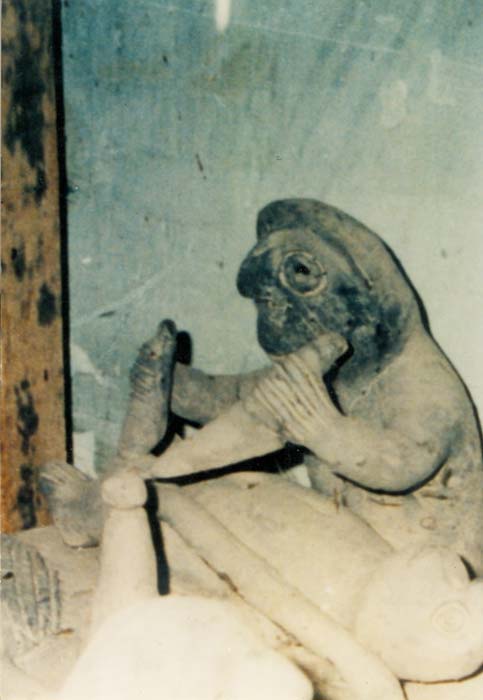
Figures in the secret collection. (© Walter Langbein)
Professor Cabrera was convinced of it. Maybe the clay figurines depicted human sacrifices? Did priests ritually sacrifice human beings thousands of year ago? Professor Cabrera vehemently objected to that supposition. He was a direct descendant of the founder of the town of Ica, Captain Don Gerónimo Luis de Cabrera y Toledo, as well as a respected and popular physician. “Look closely!” he replied almost harshly. “What do you see there?” And in fact, on one image, someone’s heart seemed to have been cut out of his chest. “A human sacrifice?” I asked myself. Another clay sculpture showed a human heart being medically treated. A creature held it in its hands; something that looked like a hose lead from a vein to a vessel.
Professor Cabrera pointed out another grouping. What I saw took my breath away. What did the clay statue depict? What served the artist as his template? Is one heart taken from a human body, and another person’s chest open to receive the heart? Does the sculpture depict a heart transplant?
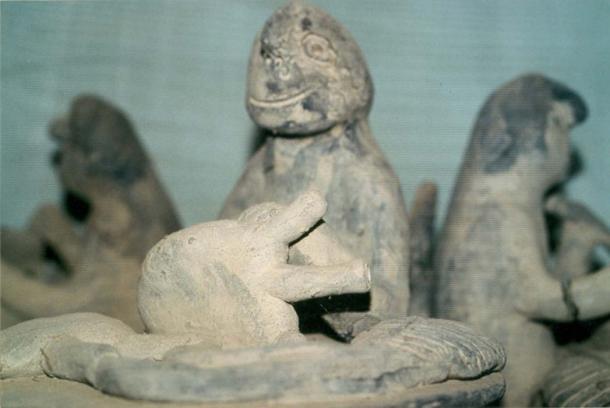
What are the humanoids doing? (© Walter Langbein)
Astonishment prompted me to say to Professor Cabrera: “Impossible! This can only be impossible…”
Are we dealing with a fake? Because, the sculpture undoubtedly did not depict a religious human sacrifice. I must agree with Professor Cabrera. A primitive human sacrifice for gods would not look like this. The sculptures did indeed depict surgeons operating on human beings. Are they transplanting hearts? But who would have supposedly carried out heart operations in the ‘old Peru’ so many thousands of years ago, let alone heart transplants? Professor Cabrera was convinced: in the region of today’s Peru existed a highly advanced civilization, an ancient culture, long before ours.
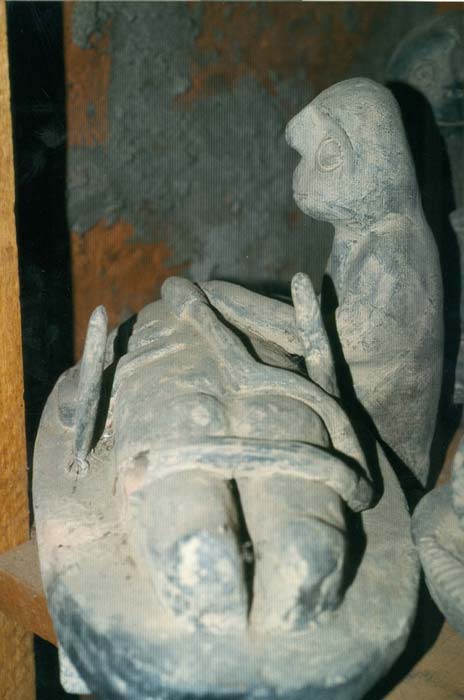
Strange sculpture in the secret collection. (© Walter Langbein)
The works of art seemed to tell a story. Are we capable of reading and understanding the clay sculptures like a book?
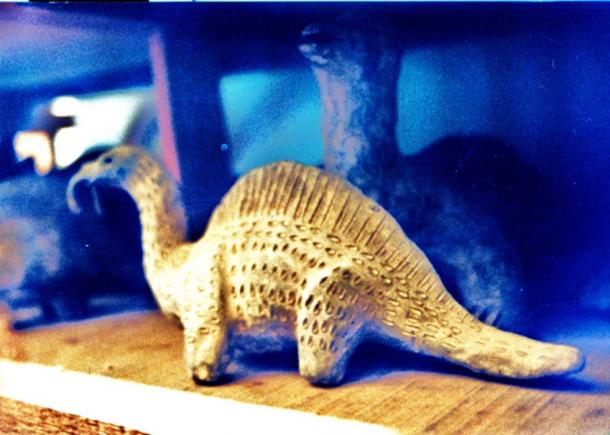
What appears to be a dinosaur sculpture in the collection of strange artifacts. (© Walter Langbein)
Investigations
For many years, only the carved stones in Professor Cabrera’s collection were known. He kept the clay sculptures a secret. Thousands of stones, with many more thousands of engravings were exhibited in Cabrera’s museum in Ica, located at the Plaza de Armas, carrying oftentimes fantastical motifs.
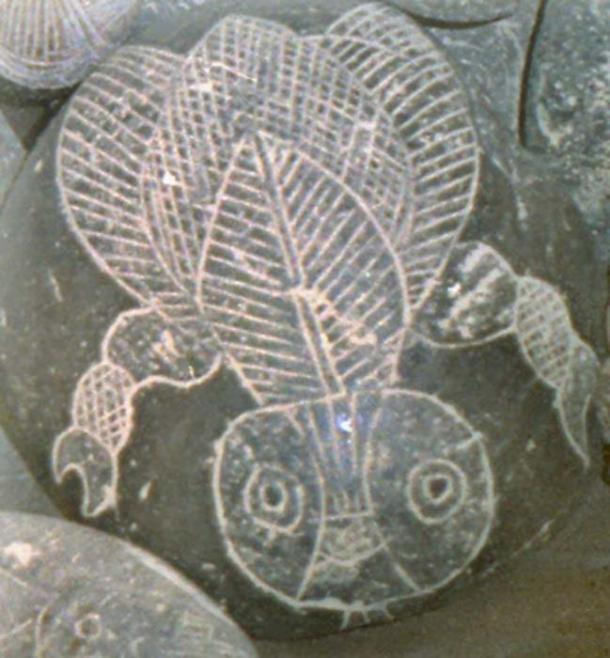
Carved stone featuring bee or insect? (© Walter Langbein)
Among others, they also depict highly complicated surgical procedures, but with an amount of fine detail that was impossible for the clay artists to give to their three-dimensional creations. The coarse clay simply did not allow for it. Therefore, artists evidently carved drawings into hard stone, with an incredible amount of recognizable details. Both the clay sculptures and the stone carvings repeatedly depict similar motifs; they would have been created at approximately the same time. But when?
- On the trail of the Father Crespi Collection: A Sad Discovery – Part II
- The Glozel Controversy – Amazing Historical Discovery or Elaborate Hoax?
- Eight Impressive but Terrifying Cases of Ancient Surgery
In the summer of 1967, the Compania Minera Mauricio Hochschild carried out an investigation into the carved stones of Professor Cabrera’s collection. The geologist Dr Erik Wolf was in charge of analyzing the layer of oxidation that had formed on top or over the carving incisions, the engravings, and that laid inside the grooves; the drawings had become covered by a very thin natural ‘glaze’. There is no question about it: the engravings must therefore be older than the oxidation layer.
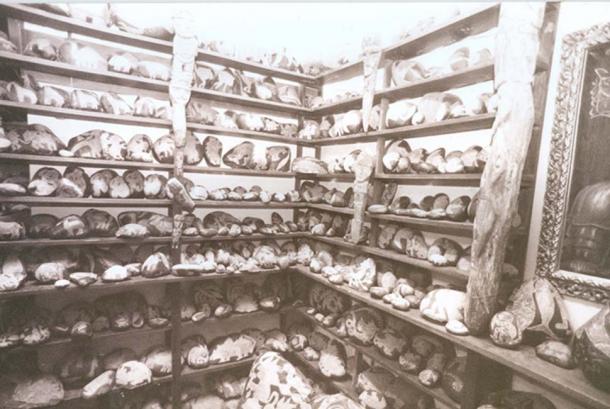
Masses of engraved stones in Professor Cabrera’s collection. (© Walter Langbein)
Even if it is nearly impossible to directly determine the age of the carvings, it is of great help to date the oxidation layer. The result reveals THE MINIMUM AGE of the drawings. In addition to Dr Erik Wolf, the Institut für Mineralogie und Petrographie an der Universität Bonn, also carried out tests. Result: the engravings must have been carved into the stone at least 12,000 years ago. They are therefore 12,000 years old…or older.
Walter J. Langbein is author of some 60 non-fiction books on mysteries of the world, many of which have become bestsellers in Europe.
--
Top Image: Hundreds and Hundreds of objects in the once-secret collection of Professor Cabrera. (Courtesy Walter-J. Langbein)
Translation by Marlies Bugmann
















Comments
So many places in the world (altho most are in South America) have stone constructions whose design and execution far exceed the known or supposed capabilities of recognized cultures. Artifacts such as these which might have supported the premise of past commumities with vastly advanced technologies are routinely dismissed because they dispute a theory espoused by so-called experts and authorities. Oral histories are dismissed as “myths” and artifacts and evidence is ignored, discredited, and discarded when it doesn’t fit the accepted norm. It puts the lie to science being based on fact.
actually the Humanoid Species that ica Stones depicts as well what the statue(that Professor Cabera's cabinet holds) are Anunnaki(anunnaki are shares the world with Dinosaurs just like we shares the world with Elehants or Girraffes)
does I'm the only one who thinks that War in Heaven are biblical/quranic takes of K-T Extinction events?
The only reason the opinion they are fake came from a court case. He lent out some stones for testing, The GVT charged him with Antiquities export. The only way to avoid the 100 year prisoon sentence was to say he had them made. These criminal charges stemmed from the stones showing Humans riding Dinosaurs, and the Smithsonian put pressure on the GVT to charge him with the crimes. In the end they got what they wanted, an elimination of evidence against the Darwin evolutionary model. These works suggest, if looked at in entirety , Humans were developed from or manipulated with Frogs. Or one species of Hominoid that is gone. The Cone Heads and Giants are also show in the works. They numbered in the 100,000 's + the metal plates which were not in this article. Also , many things are made of Lydite ,Which is flint, and is impossible to carve with the finest machine today in the same manner as these finds were. See "Klaus Dona" lectures on youtube for more info .
As most people realize all this stuff is of course FAKE !
As an archive of information, the stones and sculptures are brilliant. No lost, obscure, ancient faded or worn inscriptions to bang our heads against for decades. It is true that some of the sculptures have seemingly obscure meanings, but I think it will take far less work understanding them than it would to try and decode a twelve thousand year old dead language.
Pages